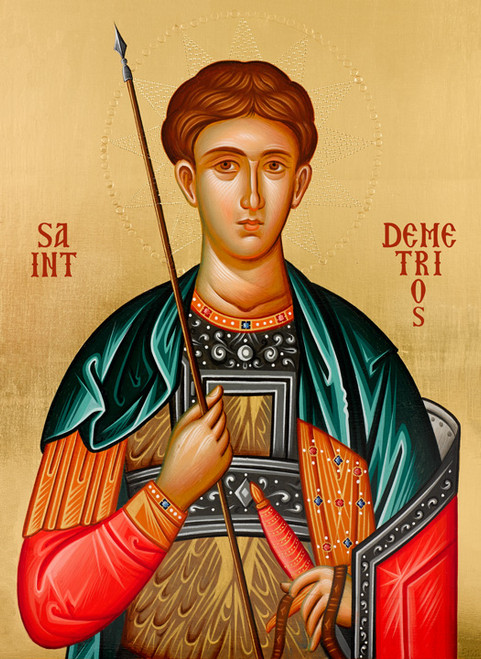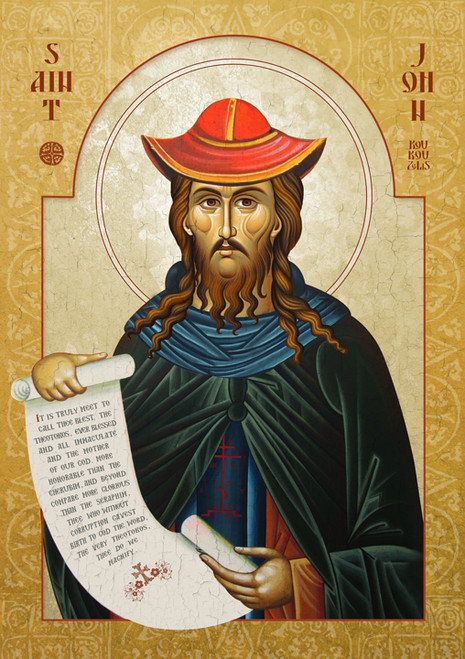St. Dymphna the Virgin-martyr & Wonderworker of Gheel (+650)
Commemorated May 15
According to tradition, St. Dymphna was the daughter of a pagan (possibly Irish) king named Damon and an unnamed Christian princess of stunning beauty. Although her mother died probably when she was approaching adolescence, she made certain to have her daughter secretly baptized a Christian and left her in the competent hands of her priest-confessor, St. Gerebern. Damon was inconsolable after the death of his beautiful wife and became very despondent. His counselors advised that he seek a second wife of noble rank; however, he was not able to find anyone as beautiful as his beloved spouse. As St. Dymphna matured, she so resembled her beautiful mother that the unnatural passions of her father were stirred and he decided that he would marry his own daughter.
Horrified at what her father proposed, St. Dymphna, together with St. Gerebern and a few attendants, fled to the continent, boarding a ship which brought them to the city of Antwerp. One tradition states that they settled in the town of Gheel near an oratory dedicated to St. Martin of Tours where they lived as hermits. Another tradition elaborates the "hermit" theory and claims that once settled in Gheel, St. Dymphna built a hospice for the poor and sick of the region. Since she was a wealthy young maiden, it is not improbable to suppose that she could have used her wealth to secure her new life in the village and its environs. God may have bestowed the gift of healing upon her since by her very courageous stance against her father, it is clear she was not a lukewarm Christian, but took her faith to heart. Her financial resources would have enabled her to easily obtain poultices and powders for healing, and this would have added to her reputation as a healer. Ironically, it is through the use of her wealth that her father would eventually ascertain her whereabouts.
After learning of their flight, Damon and his guards pursued St. Dymphna and her companions to the continent. Scouts who had been sent out ahead found a lead to their whereabouts when an innkeeper refused to accept the king's money, claiming that it was too difficult to exchange. Damon thought it very coincidental that a village innkeeper would know about foreign currency and deduced that such knowledge meant that these coins had recently passed through the innkeeper's hands. The king astutely narrowed his search to the area and eventually found St. Dymphna and her priest-confessor near the chapel of St. Martin.
Again, Damon tried to force his daughter into marriage. When St. Gerebern rebuked him for his unholy behavior, the king, careful not to kill the elderly priest with his own hands, had his guards behead him. Hoping that his daughter would come to her senses, he again ordered her to return to his kingdom and prepare for their wedding, but she adamantly refused. Furious, he pulled out his sword and beheaded her on the spot. Thus, St. Dymphna received the crown of martyrdom in defense of her chastity some time between 620 and 640 A.D. at the age of fifteen or sixteen.
The bodies of the two saints remained at the site of their martyrdom for quite some time until the inhabitants of Gheel placed the corpses in sarcophagi and entombed them in a cave. From the spot where they were martyred, healings began to occur, especially healings involving mental illness, epilepsy and demonic possession. The fame of Gheel began to spread. So astounding were the rumors of the miracles that in the thirteenth century, the saints' relics were unearthed. Fragments of two ancient sarcophagi purported to have held the bodies of the saints were found, as well as a quadrangular red tile bearing the inscription: "Here lies the holy virgin and martyr, Dymphna." The remains of St. Dymphna were placed in a small church dedicated to her at Gheel which was destroyed by fire in 1489. In 1532, another church was erected on the site, much more magnificent than the previous one, which still stands today. The relics of St. Dymphna are kept within this church in an ornate silver reliquary (pictured below). Her veneration rapidly spread all over Europe, and she became the patroness of the mentally ill, of epileptics and of abused children.
Whatever spiritual legacy of healing St. Dymphna might have pioneered in Gheel would now be powerfully resumed by her from the heavenly Kingdom. The light and love of the Holy Trinity through the intercessions of St. Dymphna would gently forge a special community where the Gospel teachings of charity and Christlike love would be exercised, evidencing the continued presence of the saint and her care and concern for both the patients and the caregivers. In fact, after the discovery of her relics in the thirteenth century, a whole settlement would develop around the veneration of St. Dymphna, taking as its model the traditional concept of the church as "spiritual hospital".
Initially, the pilgrims in need of healing were lodged in a small annex or infirmary built onto the Church of St. Dymphna. Upon their discharge, they were placed in the homes of families living in the village. From this small beginning and under St. Dymphna's patronage, the inhabitants of Gheel became known for the care they gave to those with mental illness. The town boasts of a first-class sanitarium, one of the largest and most efficient establishments for the mentally ill in the world. Gheel was the first to initiate a program of hope where the mentally ill, once released from institutional care, could realistically lead normal and productive lives in the homes of farmers and local residents. The patients, who are valued members of these "foster families", help with the chores and work to the extent of their ability. The power of St. Dymphna's intercessions is evidenced by the incredibly compassionate work of the people of Gheel for the mentally ill, as well as by the patients' progress and ability to live fully and effectively. This collaboration can only have been brought about through heavenly means, in this case, the loving patronage of St. Dymphna.
St. Dymphna is the patron saint of those who suffer from mental illnesses and nervous system disorders, epileptics, mental health professionals, incest victims, and runaways.
Alternate spellings: Dymphna, Daphne or Dafni, Dimpna or Dympna







